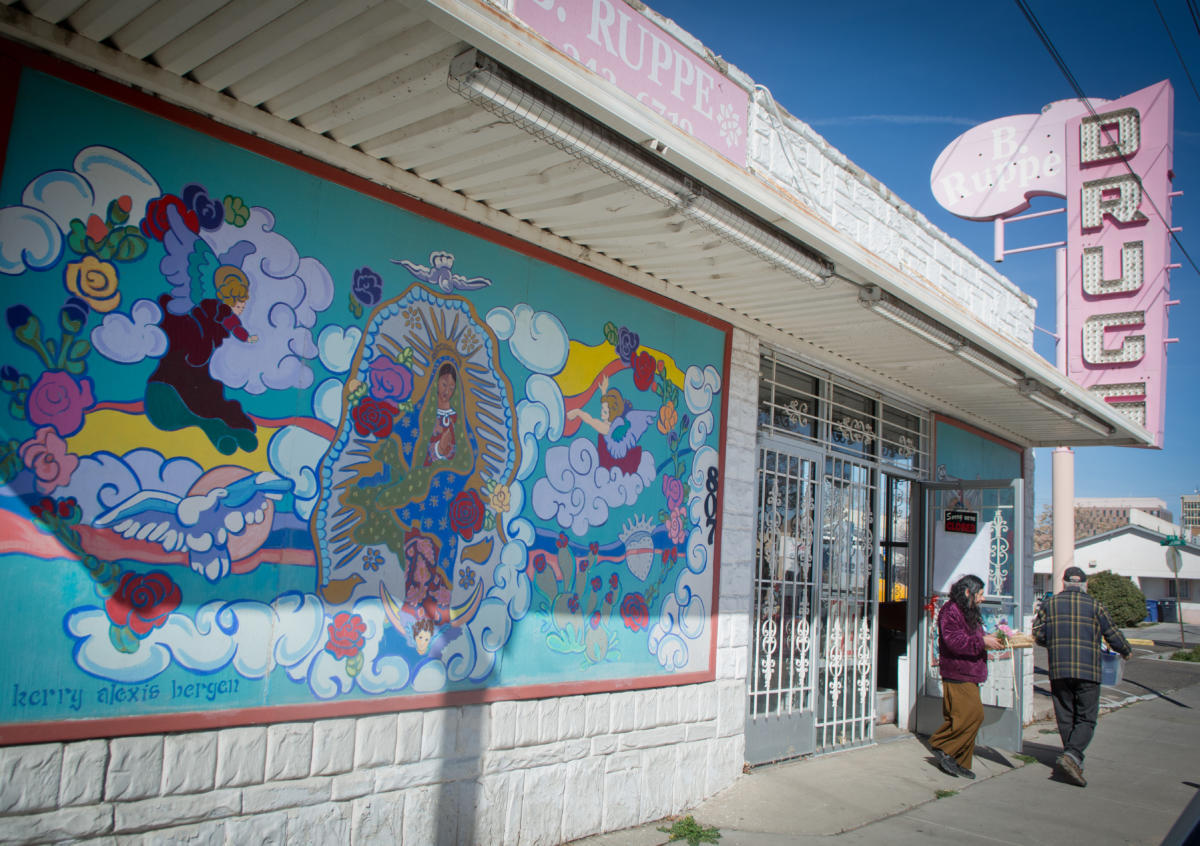By Maggie Shepard
Albuquerque Journal, N.M.
WWR Article Summary (tl;dr) The historic B. Ruppe Drugs pharmacy in Barelas may continue to be a community and cultural anchor in Barelas despite the passing of its longtime owner.
Albuquerque Journal, N.M.
Plastic shoe boxes and bags filled with mint, chamomile and many other plants still line the old wooden shelves at the historic B. Ruppe Drugs pharmacy building in Barelas.
Books and notes scribbled by pharmacy co-owner and community icon Maclovia Sanchez de Zamora still stock the back medicine racks.
Some of what remains of her and her husband’s collection of Catholic devotional statues, art and rosaries still bring color and reverence to the store space, which has been out of full service for years as Zamora phased out her herbal healing practice in her older age.
After helping keep alive one of the state’s longest continuously running pharmacies and serving as a community and cultural anchor, Zamora passed away at age 86 in December.
Now the building that hosted her life’s work and that is marked with a large mural of her is part of the revitalization effort for the neighborhood.
It has been purchased by a local nonprofit agency and is set to become, possibly, a cafe/store/community gathering and education center where Zamora’s legacy of herbalism and traditional healing can continue.
“We are going to refresh the property but keep what was historically here. So neighbors are coming and giving their input about that they want,” said Lucas Pedraza, program manager for the Barelas Mainstreet project with the Barelas Community Coalition. “The whole concept is: How do we bring the creative economy to Barelas?”
Barelas, from the railroad to the river and from about Coal to Bridge SW, is one of the oldest neighborhoods in the city with Spanish records dating to the 1600s. It once hosted a thriving railroad community, the buildings for which are coming back to life with the last years’ Rail Yards Markets’ success.
Pedraza and the coalition are hoping the pharmacy building will augment, if not anchor, the revitalization of the entire Barelas area Fourth Street corridor in the same way Zamora served as community healer.
“We got to meet Maclovia before she passed away, and it was a win-win situation,” said Elena Gonzales, director of Albuquerque operations for Homewise, the nonprofit that purchased the building. “The Barelas Community Coalition is coming up with these fantastic ideas to really keep some of the traditional healing, but also make it fit and add things that neighbors in the community want and need.”
Exactly what that will be isn’t clear as the BCC is still in the process of a series of community meetings and planning sessions. Plus, some major renovations, like the roof and HVAC system, must be tackled first.
Homewise, which helps people become homeowners, plans to pay for the building rehab, renovation and possibly the commercial kitchen.
The BCC will in turn, as it works, lease to own the building. It also plans to use several grants it has received to get the project off the ground.
Some of the dominant ideas so far for the space on Fourth Street a few blocks south of Coal include a cafe, where possibly an entrepreneur from the area or other community development programs could launch a business. There will likely be a library with Zamora’s books and notes, a “part of the store to keep (Maclovia’s) memory alive,” Pedraza said.
And that memory is alive.
On Thursday, as the BCC hosted the first of its B. Ruppe Pre-Opening Sale & Silent Auction days at the store, shoppers and old customers perused the items on auction.
Theresa Bourguet, Gonzales’ sister, looked over the medicinal and religious oils for sale and recalled her time as a customer nearly 45 years ago when she was 16.
She’d just severely burned her hand in a firework accident. Days of attention from physicians failed to keep her wounds from worsening, let alone healing. Then her mother took her to the pharmacy, just a few blocks from her house.
“The doctors said your hand will always be like that,” Bourguet said, scrunching her hand in a claw. “I came in, paid a few dollars and they sent me home with a salve. Now look, not a scar. I loved these people. They were so kind. They were truly caring people.”
Tey Marianna Nunn, curator of the Art Museum and Visual Arts Program at the National Hispanic Cultural Center, toured the store Friday, looking over the herbs and statues.
“This is a historical place,” Nunn said. “It should be saved and recognized. Maclovia was quite a special person.”
Journal staff photographer Marla Brose contributed to this report.














































































































































































































































































































































































